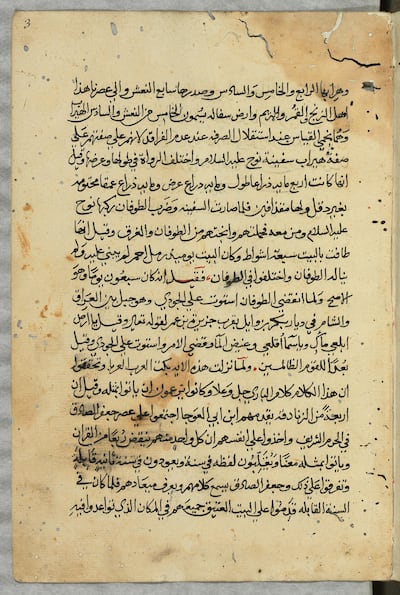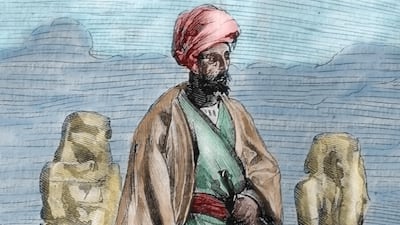What were famed Moroccan traveller Ibn Battuta’s first impressions of Sharjah more than 700 years ago? And how did Emirati navigator Ahmad Ibn Majid shape the course of maritime history?
These were among the topics explored during discussions at the Sharjah pavilion at the Rabat International Book Fair. Held in the heart of the Moroccan capital and running until April 27, the fair is in its 30th year, with Sharjah participating as guest of honour.
As part of its designation, the emirate presented a packed opening weekend programme featuring more than a dozen authors, poets and historians, highlighting the deep-rooted cultural ties between the UAE and the North African kingdom.
“It is an important relationship that still endures today, often in ways we don’t realise or tend to take for granted,” said Abdulaziz Al Musallam, chairman of the Sharjah Institute for Heritage. Speaking to The National at the book fair, he pointed to the shared linguistic roots found in everyday Arabic words across the Gulf and Morocco. “Even our Emirati dialect reflect the connection. We say ‘zein’ [good], they say ‘zwina.’ We say gahwa [coffee], they say ‘qhwa’ or ‘qahiwa’ – it’s the same word, just with different variations.”
A celebrated tie between the UAE and Oman, Al Musallam says, is the 14th-century Moroccan traveler Ibn Battuta, who sailed along the Arabian Gulf coast and is believed to have passed through Sharjah towns such as Kalba, Khor Fakkan, and Dibba – then largely under the control of Kingdom of Hormuz.
"It seems Ibn Battuta arrived during the winter, because he said Kalba had rivers and green meadows. He saw green trees and a flowing valley – it was vast and it's a place with a lot of water. Then he moved on and described Khor Fakkan too," Al Musallam says. "Then, it seems it became summer, so he went to Dibba and said that at night something came down from the sky like molasses – you know, the black syrup. What he saw was humidity. Then he entered the Gulf but didn’t refer to it as the Gulf; he called it the Sea of Siraf. That’s mentioned in some old manuscripts."
Many of these experiences are recorded in The Travels of Ibn Battuta, A.D. 1325–1354, a multi-volume work that has been translated from the original Arabic text and published in various editions over the years. Revered as a cornerstone of travel literature, Ibn Battuta’s writings owe their conversational tone and spontaneity to the fact that they were recounted from memory rather than compiled from extensive notes, Al Musallam says. The result is often a rollicking – and at times unfiltered – account of his escapades.
“He was essentially an oral storyteller. From my own experience working with such narrators over the past 30 years, you realise one storyteller can tell the same story in four different ways over four sittings – adding a little here, omitting there. It depends on the audience in that if they like a topic, the storyteller would emphasise it. If not, he downplays or hides it,” he says.
“Ibn Battuta’s travelogue represents the Arab model of the wandering narrator – someone unfiltered, sometimes painfully honest. Some people may now find this style inappropriate, but that was normal in Arab storytelling – to say things bluntly, both the good and the bad.”
As for Ahmad Ibn Majid, the 15th-century navigator born in Julfar, present-day Ras Al Khaimah, he preferred to share his maritime knowledge through poetry. Many of his verses were compiled in volumes including the seminal Kitab al-Fawa’id fi Usul ‘Ilm al-Bahr wa’l Qawa’id (The Book of Useful Information on the Principles and Rules of Navigation) – a work widely regarded as a foundational text of classical Arab navigation.
In a Saturday session exploring his influence, UAE poet and researcher Shaikha Al Mutairi states that Ahmad Ibn Majid is also credited as one of the first Arab navigators to describe the use of the compass – thought to have been invented in China as early as the 2nd century BCE and adopted for navigation by the 11th century.
“He described it as a deep cup, and at the bottom of the cup is black paper which influences the direction of the indicator,” Al Mutairi says. “His father was a great sailor, so Ahmad Ibn Majid inherited this legacy. While we don’t have many records of his father, Ahmad’s impact spread across the Gulf – not just in the UAE or Oman. Kuwaiti sailors relied heavily on his poetic navigational rhymes. So did sailors in Basra and East Africa.”
Another key reason for that wide reach, Al Mutairi notes, is how Ibn Majid transmitted dry and practical information through rajaz verses – a classical form of Arabic poetry often used for improvisation due to its short, repetitive and rhythmic style. “He uses beautiful literary expressions, powerful introductions and emotive language,” she says.
“There’s also a deeper psychological layer in his poetry. Sometimes it feels as if he’s defending himself when he says, ‘I’m fine. I’m skilled. I’m knowledgeable.’ It makes you think – what was he going through at the time? We don’t know, but he often states his name and lineage again and again – as a way of affirming his identity.”
COMPANY PROFILE
Initial investment: Undisclosed
Investment stage: Series A
Investors: Core42
Current number of staff: 47
Kill%20
%3Cp%3E%3Cstrong%3EDirector%3A%3C%2Fstrong%3E%20Nikhil%20Nagesh%20Bhat%3C%2Fp%3E%0A%3Cp%3E%3Cstrong%3EStarring%3C%2Fstrong%3E%3A%20Lakshya%2C%20Tanya%20Maniktala%2C%20Ashish%20Vidyarthi%2C%20Harsh%20Chhaya%2C%20Raghav%20Juyal%3C%2Fp%3E%0A%3Cp%3E%3Cstrong%3ERating%3A%3C%2Fstrong%3E%204.5%2F5%3Cbr%3E%3C%2Fp%3E%0A
In numbers: China in Dubai
The number of Chinese people living in Dubai: An estimated 200,000
Number of Chinese people in International City: Almost 50,000
Daily visitors to Dragon Mart in 2018/19: 120,000
Daily visitors to Dragon Mart in 2010: 20,000
Percentage increase in visitors in eight years: 500 per cent
Lexus LX700h specs
Engine: 3.4-litre twin-turbo V6 plus supplementary electric motor
Power: 464hp at 5,200rpm
Torque: 790Nm from 2,000-3,600rpm
Transmission: 10-speed auto
Fuel consumption: 11.7L/100km
On sale: Now
Price: From Dh590,000
WHAT IS A BLACK HOLE?
1. Black holes are objects whose gravity is so strong not even light can escape their pull
2. They can be created when massive stars collapse under their own weight
3. Large black holes can also be formed when smaller ones collide and merge
4. The biggest black holes lurk at the centre of many galaxies, including our own
5. Astronomers believe that when the universe was very young, black holes affected how galaxies formed
UAE currency: the story behind the money in your pockets
Dhadak 2
Director: Shazia Iqbal
Starring: Siddhant Chaturvedi, Triptii Dimri
Rating: 1/5
Springsteen: Deliver Me from Nowhere
Director: Scott Cooper
Starring: Jeremy Allen White, Odessa Young, Jeremy Strong
Rating: 4/5
SPEC%20SHEET%3A%20APPLE%20M3%20MACBOOK%20AIR%20(13%22)
%3Cp%3E%3Cstrong%3EProcessor%3A%3C%2Fstrong%3E%20Apple%20M3%2C%208-core%20CPU%2C%20up%20to%2010-core%20CPU%2C%2016-core%20Neural%20Engine%3C%2Fp%3E%0A%3Cp%3E%3Cstrong%3EDisplay%3A%3C%2Fstrong%3E%2013.6-inch%20Liquid%20Retina%2C%202560%20x%201664%2C%20224ppi%2C%20500%20nits%2C%20True%20Tone%2C%20wide%20colour%3C%2Fp%3E%0A%3Cp%3E%3Cstrong%3EMemory%3A%3C%2Fstrong%3E%208%2F16%2F24GB%3C%2Fp%3E%0A%3Cp%3E%3Cstrong%3EStorage%3A%3C%2Fstrong%3E%20256%2F512GB%20%2F%201%2F2TB%3C%2Fp%3E%0A%3Cp%3E%3Cstrong%3EI%2FO%3A%3C%2Fstrong%3E%20Thunderbolt%203%2FUSB-4%20(2)%2C%203.5mm%20audio%2C%20Touch%20ID%3C%2Fp%3E%0A%3Cp%3E%3Cstrong%3EConnectivity%3A%3C%2Fstrong%3E%20Wi-Fi%206E%2C%20Bluetooth%205.3%3C%2Fp%3E%0A%3Cp%3E%3Cstrong%3EBattery%3A%3C%2Fstrong%3E%2052.6Wh%20lithium-polymer%2C%20up%20to%2018%20hours%2C%20MagSafe%20charging%3C%2Fp%3E%0A%3Cp%3E%3Cstrong%3ECamera%3A%3C%2Fstrong%3E%201080p%20FaceTime%20HD%3C%2Fp%3E%0A%3Cp%3E%3Cstrong%3EVideo%3A%3C%2Fstrong%3E%20Support%20for%20Apple%20ProRes%2C%20HDR%20with%20Dolby%20Vision%2C%20HDR10%3C%2Fp%3E%0A%3Cp%3E%3Cstrong%3EAudio%3A%3C%2Fstrong%3E%204-speaker%20system%2C%20wide%20stereo%2C%20support%20for%20Dolby%20Atmos%2C%20Spatial%20Audio%20and%20dynamic%20head%20tracking%20(with%20AirPods)%3C%2Fp%3E%0A%3Cp%3E%3Cstrong%3EColours%3A%3C%2Fstrong%3E%20Midnight%2C%20silver%2C%20space%20grey%2C%20starlight%3C%2Fp%3E%0A%3Cp%3E%3Cstrong%3EIn%20the%20box%3A%3C%2Fstrong%3E%20MacBook%20Air%2C%2030W%2F35W%20dual-port%2F70w%20power%20adapter%2C%20USB-C-to-MagSafe%20cable%2C%202%20Apple%20stickers%3C%2Fp%3E%0A%3Cp%3E%3Cstrong%3EPrice%3A%3C%2Fstrong%3E%20From%20Dh4%2C599%3C%2Fp%3E%0A
UAE currency: the story behind the money in your pockets
GAC GS8 Specs
Engine: 2.0-litre 4cyl turbo
Power: 248hp at 5,200rpm
Torque: 400Nm at 1,750-4,000rpm
Transmission: 8-speed auto
Fuel consumption: 9.1L/100km
On sale: Now
Price: From Dh149,900
TOURNAMENT INFO
Women’s World Twenty20 Qualifier
Jul 3- 14, in the Netherlands
The top two teams will qualify to play at the World T20 in the West Indies in November
UAE squad
Humaira Tasneem (captain), Chamani Seneviratne, Subha Srinivasan, Neha Sharma, Kavisha Kumari, Judit Cleetus, Chaya Mughal, Roopa Nagraj, Heena Hotchandani, Namita D’Souza, Ishani Senevirathne, Esha Oza, Nisha Ali, Udeni Kuruppuarachchi
The years Ramadan fell in May
Score
New Zealand 266 for 9 in 50 overs
Pakistan 219 all out in 47.2 overs
New Zealand win by 47 runs
New Zealand lead three-match ODI series 1-0
Next match: Zayed Cricket Stadium, Abu Dhabi, Friday
Tamkeen's offering
- Option 1: 70% in year 1, 50% in year 2, 30% in year 3
- Option 2: 50% across three years
- Option 3: 30% across five years
Scores
Wales 74-24 Tonga
England 35-15 Japan
Italy 7-26 Australia
Ferrari 12Cilindri specs
Engine: naturally aspirated 6.5-liter V12
Power: 819hp
Torque: 678Nm at 7,250rpm
Price: From Dh1,700,000
Available: Now
The specs: Macan Turbo
Engine: Dual synchronous electric motors
Power: 639hp
Torque: 1,130Nm
Transmission: Single-speed automatic
Touring range: 591km
Price: From Dh412,500
On sale: Deliveries start in October
Ruwais timeline
1971 Abu Dhabi National Oil Company established
1980 Ruwais Housing Complex built, located 10 kilometres away from industrial plants
1982 120,000 bpd capacity Ruwais refinery complex officially inaugurated by the founder of the UAE Sheikh Zayed
1984 Second phase of Ruwais Housing Complex built. Today the 7,000-unit complex houses some 24,000 people.
1985 The refinery is expanded with the commissioning of a 27,000 b/d hydro cracker complex
2009 Plans announced to build $1.2 billion fertilizer plant in Ruwais, producing urea
2010 Adnoc awards $10bn contracts for expansion of Ruwais refinery, to double capacity from 415,000 bpd
2014 Ruwais 261-outlet shopping mall opens
2014 Production starts at newly expanded Ruwais refinery, providing jet fuel and diesel and allowing the UAE to be self-sufficient for petrol supplies
2014 Etihad Rail begins transportation of sulphur from Shah and Habshan to Ruwais for export
2017 Aldar Academies to operate Adnoc’s schools including in Ruwais from September. Eight schools operate in total within the housing complex.
2018 Adnoc announces plans to invest $3.1 billion on upgrading its Ruwais refinery
2018 NMC Healthcare selected to manage operations of Ruwais Hospital
2018 Adnoc announces new downstream strategy at event in Abu Dhabi on May 13
Source: The National
MATCH INFO
Inter Milan 2 (Vecino 65', Barella 83')
Verona 1 (Verre 19' pen)




